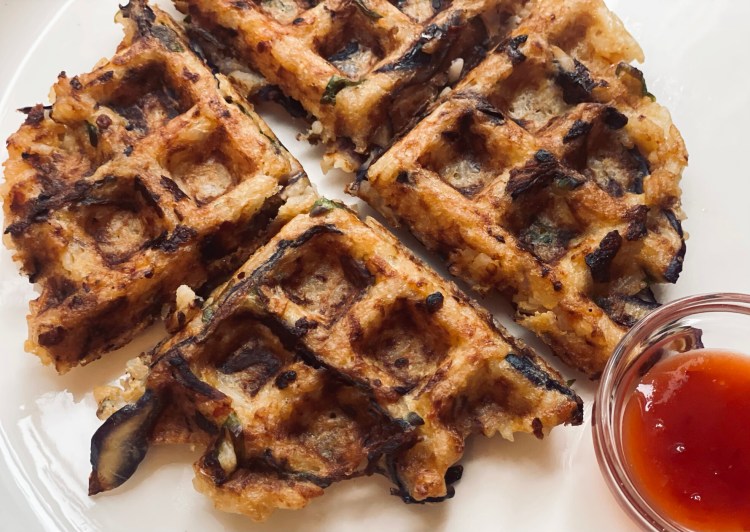The waffle process – pressing batter or dough between patterned hot plates – has been used to bring all sorts of foods to the table. There are Belgian waffles, waffle fries, toaster waffles and waffle cones. Also bubble waffles, croffles (made from croissant dough), stroopwafels and pizzelles. But what about repurposing the various leftovers in my fridge into waffles?
I’ve read about folks getting mixed results when they’ve tried to reheat Thanksgiving stuffing using a waffle iron. I’ve watched social media videos on how to make waffle omelets with bits of already cooked veggies. I know from experience that leftover mashed potatoes – sweet or white – work well in waffles and only need a bit of gravy to turn them into a meal. And, in a pinch, I’ve pressed my waffle iron into service as a panini maker.
But as I stood in my kitchen watching cheesy bechamel sauce ooze out the sides of my electric waffle maker onto the counter, I waffled on my assertion that the gadget could transform any dinner leftover I threw at it into a crunchier, hand-held snack version of itself. While baked mac and cheese does indeed get pleasantly revived because the irons nicely brown and crisp it up from every angle, it turns out putting stovetop mac and cheese between the waffled irons was a big, messy mistake.

Don’t let your waffle iron be a one-hit wonder. Use it to repurpose all manner of leftovers into snacks. Photo by Christine Burns Rudalevige
I’ll take that one failure for the team of folks looking to winnow down the number of one-hit wonder gadgets in their kitchen. Why spend the resources – monetary and environmentally – on a tool that only does a single job? My subsequent testing clearly shows that the waffle iron is worth more than the price you paid for it to make Belgian-style waffles for brunch a couple of times a year.
As with most things in life and in the kitchen, it’s helpful to abide by a few rules when repurposing a waffle iron into a food-waste reducing snack maker.
Rule No. 1. Use a binder.
Whether we’re talking about a bag of shredded hash brown potatoes in the back of the freezer, or the leftover vegetable biriyani from last night, you need to add either a beaten egg or a handful of cheese to hold things together. For every cup of other ingredients, add one egg or 1 ounce of shredded cheese.
Rule No. 2: Grease the skids well.
The nooks and grannies of the waffle iron are what gives the foods it cooks maximum crispy crunch. But even in a nonstick situation, giving both the upper and lower irons a good coating of neutral oil will both add to the crunch and simplify cleanup.
Rule No. 3: Watch the stuffing.
Stick to the manufacturer’s guidelines on how much food your waffle maker can handle at one time. My small, very basic Oster can handle about 1 cup, placed in the very middle of the bottom plate and spread to within a half-inch of edge of the maker before I close it.
Rule No. 4. Have a solid exit plan.
I use a set of tongs to transfer a classic waffle from iron to plate. But leftovers cooked in the iron and bound by egg or cheese may need a little more support. Lift the edge of a leftovers waffle with tongs, and then slide a fish spatula under it to help move it to where it needs to be in a single piece.
Rule No. 5: Season it while it’s hot.
As with fried foods, salt your waffled food when it’s hot. That helps the salt stick.
Rule No. 6: Cool slightly before cutting.
Giving the waffle-ized snack a minute to rest before portioning it gives you the best odds for nice, clean cuts.
————————-
Walking Fried Rice Waffle
Walking tacos (a snack-sized bag of Fritos that is topped off with taco meat, cheese and salsa) are served from the snack bar at sporting events because they are easy to eat while the eater is wandering the sidelines of a game. This Walking Waffle provides the same on-the-go convenience.
Makes 1 waffle; Serves 4 as a snack
3/4 cup cooked rice
1/4 cup thinly shaved cabbage
2 tablespoons thinly sliced scallion tops
1 teaspoon soy sauce
1/2 teaspoon grated fresh ginger
1/2 teaspoon grated garlic
1/2 teaspoon miso
1/2 teaspoon chili oil
1/2 teaspoon sesame oil
1/2 teaspoon sambal olek
1 egg, beaten
Neutral oil
1/2 teaspoon furikake, to serve
In a bowl, combine the rice, cabbage, scallions, soy sauce, ginger, garlic, miso, chili and sesame oils, and sambal olek. Taste the mixture and add more soy sauce if needed. Stir in the egg.
Preheat the waffle iron to high. Coat the upper and lower irons well with neutral oil, such as canola or grape seed oil. Pour the rice mixture into the middle of the bottom waffle iron and use a spoon to spread it almost to the edges all around. Close the waffle maker and cook until the indicator light signals that it is done. Check to make sure the waffle is very crispy. If not, close and cook for a minute more.
Carefully transfer the waffle to a cutting board. Sprinkle furikake over it. Wait 2 minutes before cutting it into 4 servings. Enjoy warm.
Local foods advocate Christine Burns Rudalevige is the editor of Edible Maine magazine and the author of “Green Plate Special,” both a column about eating sustainably in the Portland Press Herald and the name of her 2017 cookbook. She can be contacted at: cburns1227@gmail.com
Send questions/comments to the editors.


